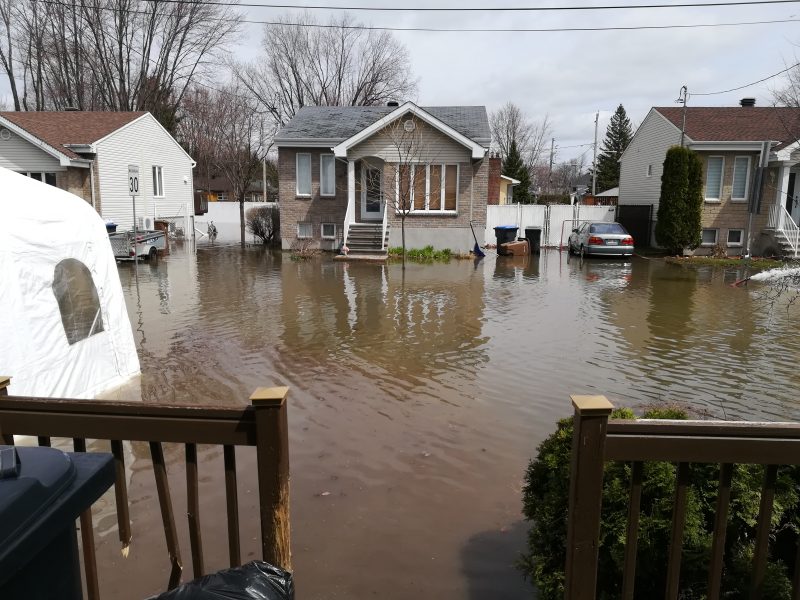At around 11:30 p.m. on April 27, an officer knocked on the front door of my home in Ste-Marthe-sur-le-Lac. They informed my family and I that we were under mandatory evacuation. The water levels had been steadily rising since the dike broke a few hours prior, at around 7 p.m., and we knew it would eventually reach our house.
We spent a lot of the evening walking around the neighbourhood, trying to speak to as many people as possible to better understand and assess the situation we were in. The other part was spent packing and preparing for the worst.
It wasn’t until 8 a.m. the next morning that we got a call from one of our neighbours, who told us the water was now a few inches below our front door. My mom was devastated; she spent the past 20 years making that house our home and the thought of losing it made all of us heartbroken.
Later that day, when we were finally able to get to our house, after having walked through waist-high water, we saw the extent of the damage to our town. Debris was floating around, windows of houses were broken and people were rushing around, trying to save as much as possible.
We were incredibly lucky. We had the time to prepare ourselves and our house, and for a few hours, we were even allowed to return after the water came, but others weren’t so lucky.
“I had to leave within nine minutes,” said Bridgette Pruneau, one of the affected citizens. “In nine minutes, I had to leave my whole life behind.” She was one among hundreds of others who had only moments to grab their most prized possessions and leave the rest behind.
“The government put the dikes in place to avoid having a situation like this happen,” said Kim Doucet, another one of the evacuees. “But because of negligence, it happened, and it’s so much worse. We weren’t able to prepare ourselves properly because we thought the dike would hold.”
The last major flood in Ste-Marthe-sur-le-Lac was in 1976, which is also when the government decided to build the dike. According to a study led by l’École Polytechnique de Montréal, the provincial government wanted to map out the flood zones and establish preventive measures to reduce damages caused by floods. The dike had held up for over 40 years, making the area a no-flood-risk zone.
The citizens of Ste-Marthe-sur-le-Lac suffered a great loss that day: our homes, our memories and much more – but we didn’t expect the effects of this loss to last so long. It’s been six months since the floods, and most citizens still haven’t returned to a normal way of life. Some may never be able to.
The majority of people affected by the flood are frustrated with the government. The process of getting information or funding to repair the damages is incredibly complicated and time consuming.
“I’m now out on the street with four animals to take care of and no home to return to,” said Pruneau. “The government isn’t helping us, nor sharing information with us, information that could help us with our next step.”
One of my neighbours, Jean-Guy Leprohon, spent approximately $20,000 to fix the damages to his house caused by the flood. The city sent an inspector to verify if it was deemed safe to live in. If deemed unsafe, the municipal government offered three options: move, repair the house, or to demolish and rebuild. Last week, he was informed that his home would have to be demolished.
He’s happy that he and his family will soon have a safe home to live in, but the fact that it took so long for someone to come and properly inspect the house is very disappointing. Had he known that his house would be demolished, he never would have invested so much into the repairs. The Ministry of Public Security (MSP) sent an inspector in May to act as the eyes of the government and report on the damages. The report that the inspector sent to the MSP is quite different from the report that was made by the city one.
“When the inspector came to assess the damage at my home, he was not dressed to assess such a situation,” said Doucet. “He didn’t bother going downstairs, he just took pictures of the pictures that I took. That’s it.”
In a Facebook group created by the flood victims, many people have come forward with similar claims. Among them, many have also shared that they are still waiting for money from the provincial government. They have shown concern over the fact that winter is coming, but the money promised from the government isn’t.
“I feel like a prisoner in my own home,” said Doucet. “I can’t afford to leave, nor can I afford to fix things.”
Photos by Victoria Blair
